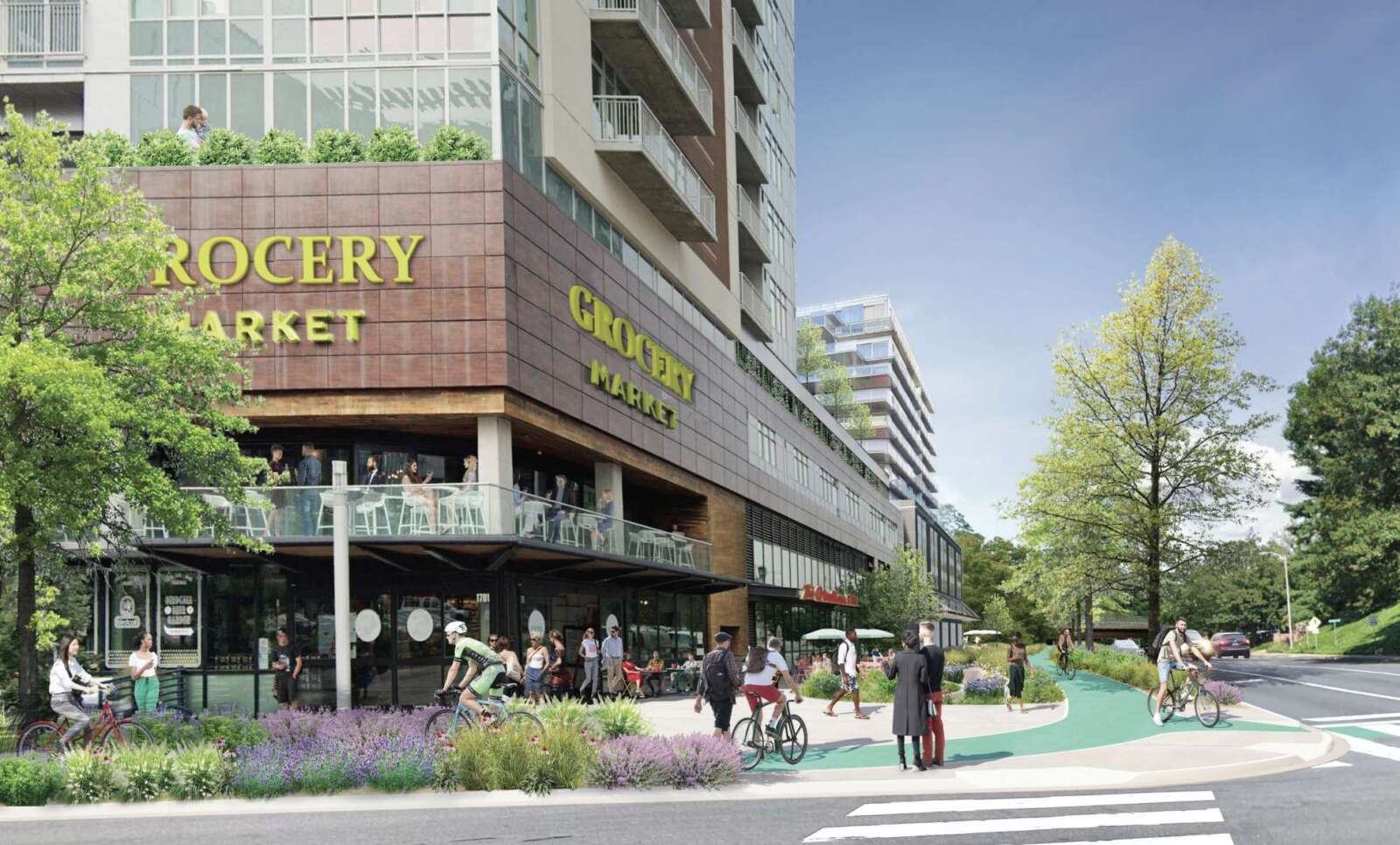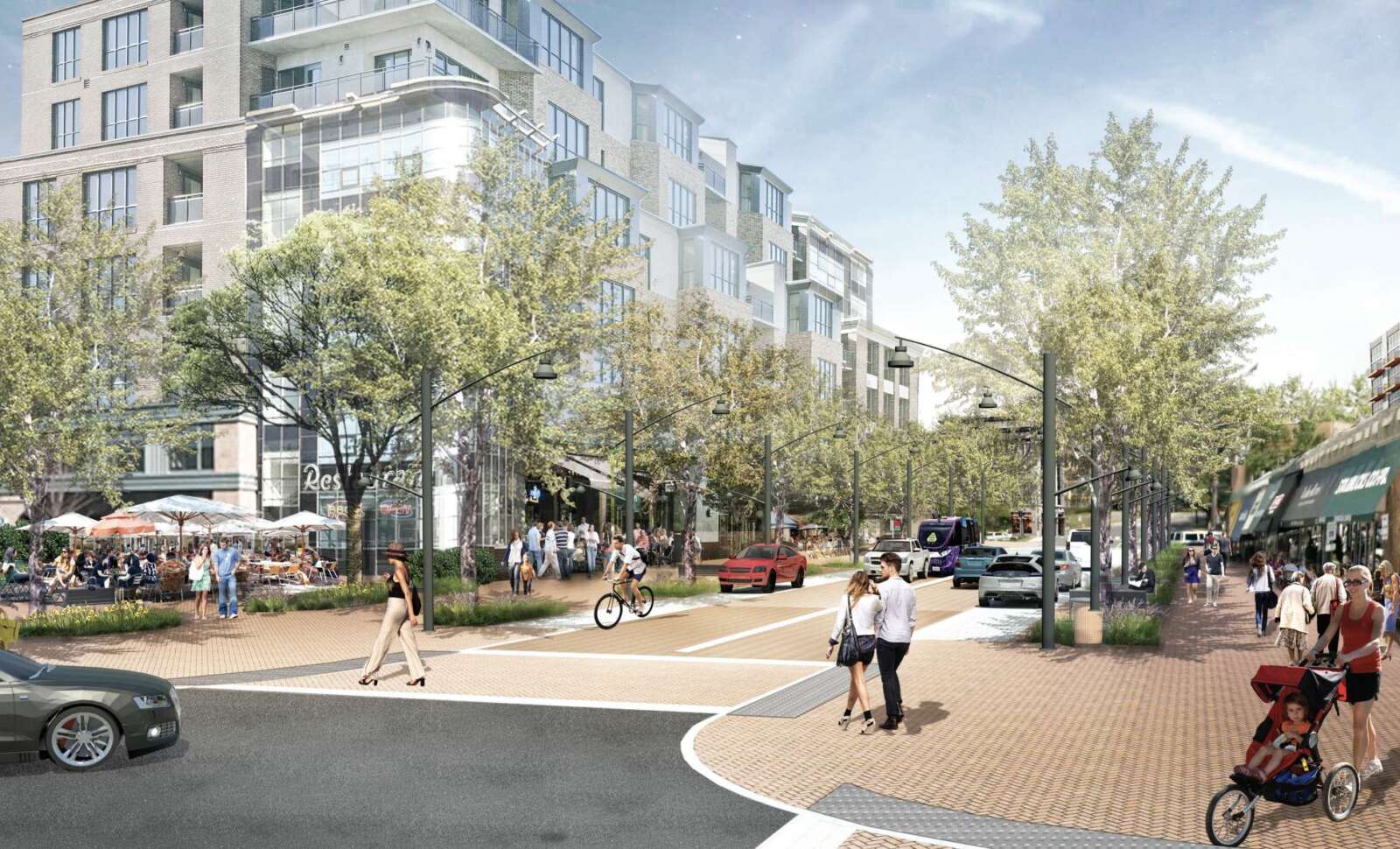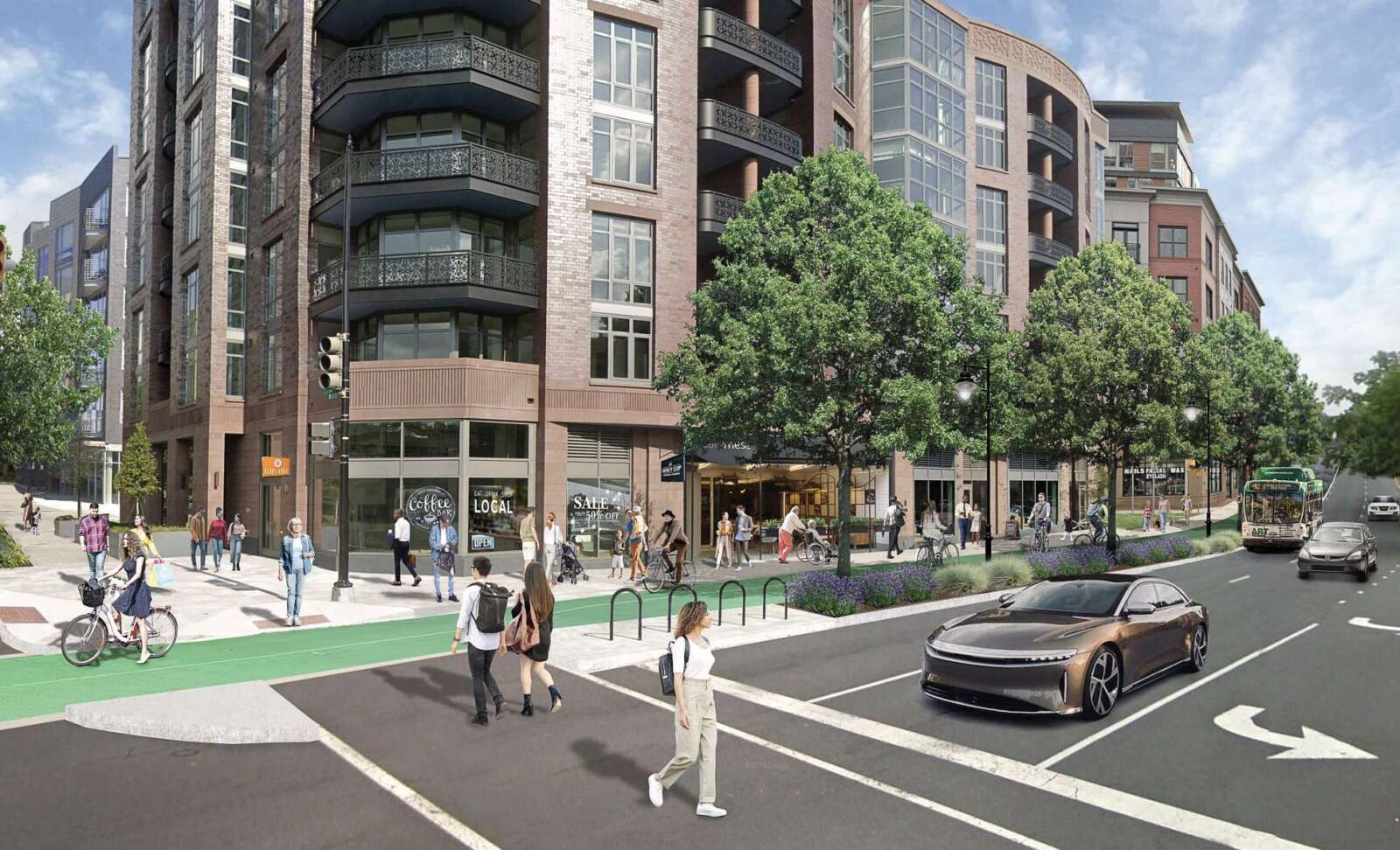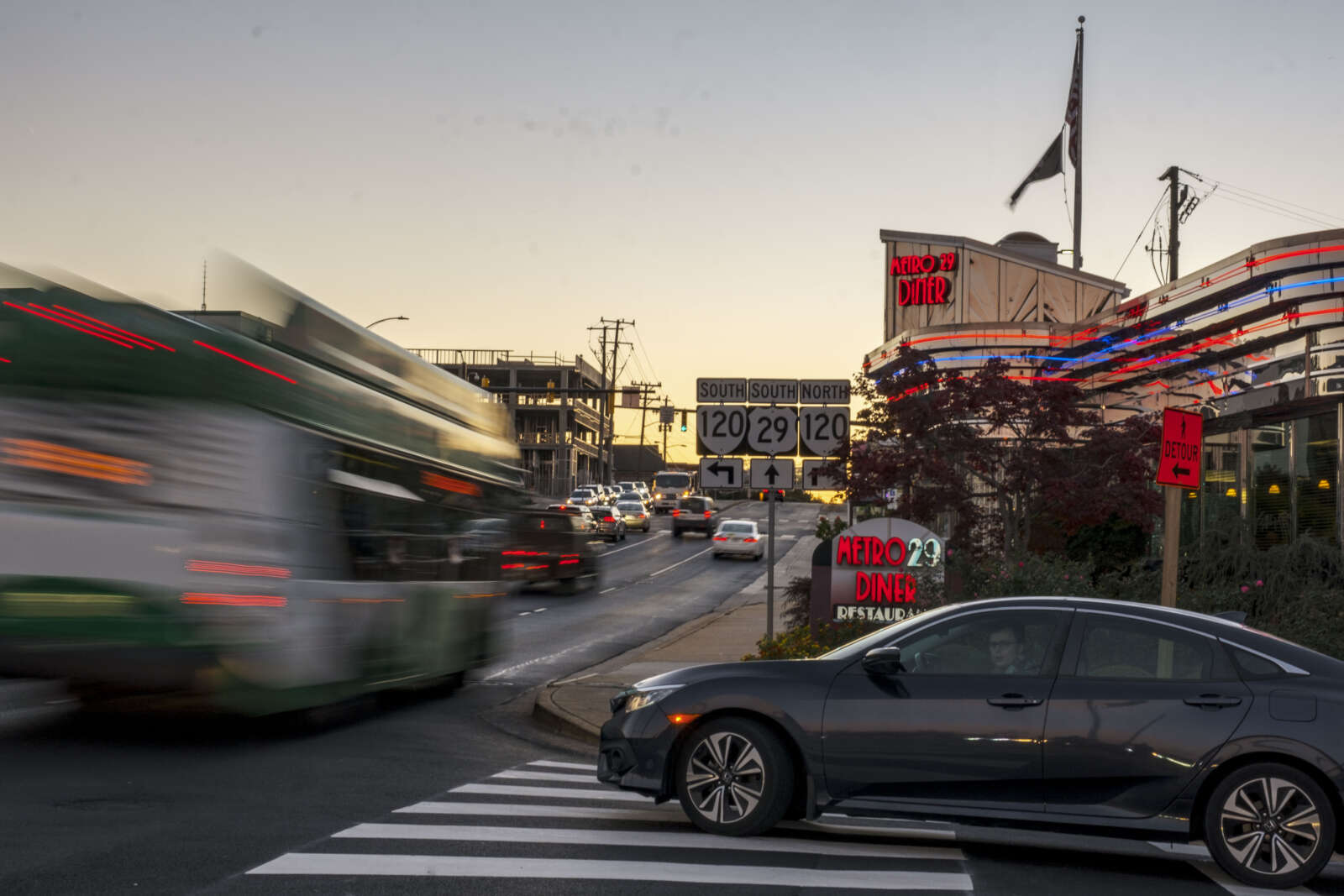(Updated 3:50 p.m.) Arlington County has published a new draft plan outlining how to encourage private development on Langston Blvd to turn it into a walkable, bikeable corridor with apartment buildings and public spaces.
The plan, released last week, follows up on a more conceptual document released last year. This document introduced the vision for less dense neighborhoods giving way to “activity hubs,” such as the Lyon Village Shopping Center, developed with 15-story apartment buildings.
Since then, the county says it made several changes responding to public feedback calling for more housing, especially affordable housing, and more incentives to generate public benefits. The plan leverages new housing construction to preserve historical properties — like the decades-old Moore’s Barber Shop in the Hall’s Hill neighborhood — and inject the area with new stormwater infrastructure, privately-owned public spaces, new east-west roads, streetscapes, and trail connections.
The new draft calls for taller allowable heights in certain areas, a general increase in housing units that could be built throughout the corridor, more public spaces and buffered bicycle lanes. It recommends policy and zoning changes and publicly funded infrastructure projects to facilitate the new development and has a timeline assigning tasks to various county divisions.
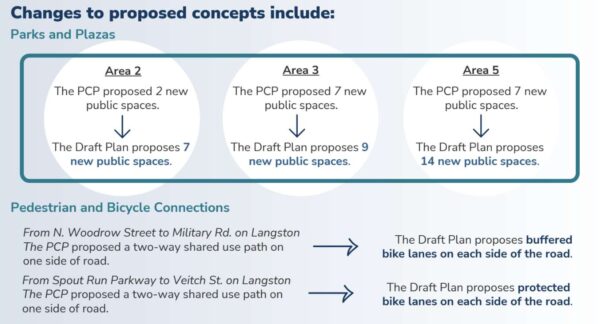
Alreadly, the draft plan has generated positive reception by some in the community, but also criticism by others of specific elements. One general criticism: the reliance on private development to deliver public spaces and needed infrastructure, especially stormwater management.
This follows divergent feedback over the last year about how, and whether, the corridor should develop — though neighbors are more united around transportation and streetscape upgrades for Langston Blvd.
Cherrydale Civic Association President Jim Todd says he was surprised to see the number of housing units go up. The 2022 concept plan estimated 8,431 new units could be possible. The new draft brought up the estimate to 9,400 new units.
The unit increase responds to calls from several residents, local advocacy groups and citizen commissions, according to Plan Langston Blvd Coordinator Natasha Alfonso-Ahmed. These comments stressed the importance of Langston Blvd for reaching a county goal to increase affordable housing in North Arlington by 2040.
Planners increased allowable heights in certain areas to further incentivize developers to build community benefits and deliver affordable housing, while updating guidance to ensure these buildings taper down to low-rise homes nearby.
Heights are now up to 15 stories in some places immediately south of I-66, where previously a 12-story limit was considered. Elsewhere in the North Highlands area, north of Rosslyn, heights are up to 12 stories, instead of 10. The same increase occurred across from the Lyon Village Shopping Center.
Elsewhere, allowable heights increased from seven to 10 stories near the Lee Heights Shopping Center and at the intersection with N. Oak Street. Upper limits increased from five to six stories at the intersection with N. George Mason Drive and south of Langston Blvd, west of Rosslyn.
Additionally, the county added 14 more public spaces to the plan and converted “sharrows” — where bicyclists and drivers share the road — into buffered bike lanes in two places.
Transit advocate Gillian Burgess welcomed the removal of “sharrows” and lauded the occasional protected bike lanes, undergrounded utilities and parking and increased transit.
Overall, however, she says the plan falls short of making travel safe and sustainable. Instead, it waits for more people to opt to ride the bus to improve bus service, through increased service and bus-priority signals.
“This is not a plan that will enable children to get to school on their own. This is not a plan that will enable an equitable transportation system. This is not a plan that reduce many car trips in favor of more safe and sustainable modes,” she said. “As our ideal, long-term goal, knowing what we know and with the technology we have in 2023, this is disappointing.”
The mixed reactions to the plan come in the wake of the controversial Missing Middle zoning ordinance changes in March.
Former Planning Commissioner Brian Harner, who co-published an alternative to the Missing Middle proposal, says he generally approves, after advocating for this plan a decade ago.
“In general, this is a great plan that represents the kind of comprehensive and integrated planning we need to be doing in Arlington,” said Harner. “There are a few areas where refinements can be made, but the framework and vision are solid and good for Arlington.”
Todd, the Cherrydale Civic Association president, said some people he talks to are conflicted.
“A lot of people are taken aback by it at first and their impression is, ‘This is a giveaway to developers and the county is too cozy with them,'” he said. “As they understand it, they’re on board with the larger goals, but I think it requires more than just counting on developers. I think it really also requires public investment.”
Arlingtonians for Our Sustainable Future, a slow-growth group staunchly opposed to Missing Middle, says the county needs to focus planning efforts on stopping the bleeding from a 22% commercial office vacancy rate and a $750 million Metro shortfall, rather than draft a plan encouraging new housing decades from now.
“[The plan] is aspirational, and a very slick marketing tool, but it provides no mechanism to deliver the schools, major stormwater detention facilities, new rec centers, libraries, and larger parks that Arlington expects,” said Anne Bodine, an ASF representative.
“[The plan] is another chapter in Arlington’s ceaseless march to gentrify, larded — much like the marketing for urban renewal in the 50s and 60s — with claims we need to ‘revitalize’ areas or ‘integrate experiences’ such as shopping, eating and wellness, even while we have such areas now across the corridor,” she continued.
When it comes to public amenities, the plan suggests consolidating recreation centers and co-locating a library with other public uses or pursuing one via joint development, such as the planned Crystal City Library. Stormwater detention facilities could go under privately owned public spaces.
Langston Blvd Alliance board member Michelle Winters does not share Bodine’s pessimism. Given the right conditions, large-scale projects can achieve infrastructure improvements, says Winters. Currently, developers can build up to four stories by-right but are not often choosing to, due to factors such as undersized lots and parking minimums.
With the draft out, Arlington County wants to hear from residents now through July 30. There will be open houses at the Plan Langston Blvd Design Studio (4500 Langston Blvd) on the following dates:
- Wednesday, July 12, from 12:30-2 p.m.
- Wednesday, July 12, from 6:30-8:30 p.m.
- Thursday, July 20, from 12:30-2 p.m.
- Thursday, July 20, from 6:30 p.m.-8:30 p.m.
- Wednesday, July 26, 12:30-2 p.m.
- Wednesday, July 26, 6:30-8:30 p.m.
A second draft could be ready for Planning Commission and Arlington County Board hearings in September or October, though ASF advocates for a delay until two new County Board members join in January 2024.


